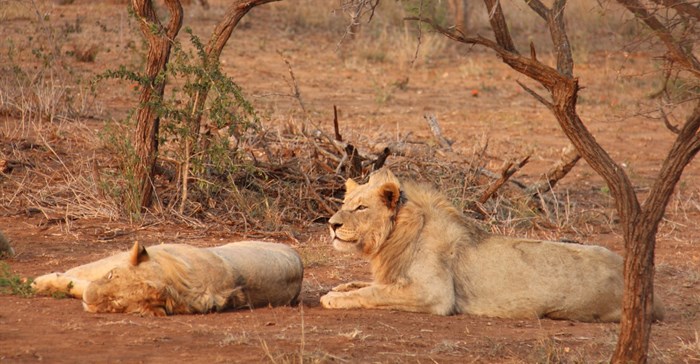New lion blood line introduced in iSimangaliso Wetland Park

The lions, from the Tswalu Kalahari Reserve, are genetically distinct from the pride of 13 lions presently residing in iSimangaliso, all of which are from the same blood line. The lions will remain in the bomas for several weeks and will then be released into the wild during October to acquaint themselves with the existing pride.
This introduction is part of the plan to bring lions back to iSimangaliso after 44 years of absence. Forty-seven years ago the last lion was shot by conservation for going “rogue” from what was then an unfenced park. The first introductions took place in December 2013 and 2014 respectively.
The first family of four lions - translocated from Tembe Elephant Park - were released in December 2013 and comprised an adult female and three sub-adult offspring. Their arrival catapulted iSimangaliso to ‘Big 7’ status. This was followed by the coalition of two males (brothers) and three females during the course of 2014.
Slow breeding rate
In order to slow down the breeding rate of the lions, the females underwent partial hysterectomies. This requires the removal of one horn of the uterus. Lions breed prolifically and this action should halve the number of litters, obviating the need for translocations to other parks in the short-term. Since December 2013, two sets of cubs swelled the ranks and the total number of lions at present is 13.
“This historic introduction brings iSimangaliso closer to achieving its conservation vision: the full restoration of ecosystems functioning, and the re-establishment of the migratory patterns of historically occurring animal populations – from the top of the Lebombo mountains to the sea – as they occurred in the times of Shaka and before fencing fragmented the landscape and constrained animal movements. It is a reversal of the historic decimation of game for apartheid military bases, commercial plantations and other agriculture,” says iSimangaliso CEO, Andrew Zaloumis.
Zaloumis explains that the reintroduction of lions back into uMkhuze is the result of 15 years of hard work by iSimangaliso staff. It follows the settling of land claims, the removal of thousands of hectares of commercial eucalyptus and pine plantations and the construction of over 350km of "Big 5" fencing.
Job creation
Much of this work has been undertaken by community SMMEs, creating significant employment in an area marked by unemployment and poverty. Fencing was done by agreement with communities, involving negotiations with seven traditional council chiefs and dozens of isigodi’s (wards).
“In addition to the ecological benefits, the introduction of lion has boosted tourism arrivals to the uMkhuze section of iSimangaliso. The pride of lion are regularly seen along with the two packs of painted dogs,” adds Zaloumis.
All adult lions are fitted with satellite collars to monitor their movements for biological and safety reasons. They are tracked daily by park staff supported by Wildlife Act volunteers with the information feeding into park management.
A translocation is the culmination of the efforts of numerous parties and iSimangaliso has expressed its sincere thanks to the combined contributions of all who continue to assist conservation.
Project contributors
“In particular,” says Zaloumis, “we acknowledge the donation of the lions by Tswalu Kalahari Reserve, the Bateleur Society for aircraft and flights and Mr and Mrs Van Langelaars for their donation to fuel costs and the many participants in iSimangaliso’s eco-series events whose contribution to the Rare and Endangered Species Fund has covered the cost of immobilising drugs and collars. Thank you also to the conservation staff of Ezemvelo KZN Wildlife and Wildlife ACT who are also a significant part of the success of the project.”
Key terrestrial animals have been introduced at iSimangaliso, including lion, cheetah, wild dog, rhino, tsessebe and oribi. Marine life includes protected whale and sharks populations, coelacanths, turtles as well as myriad species on the coral reefs.


















